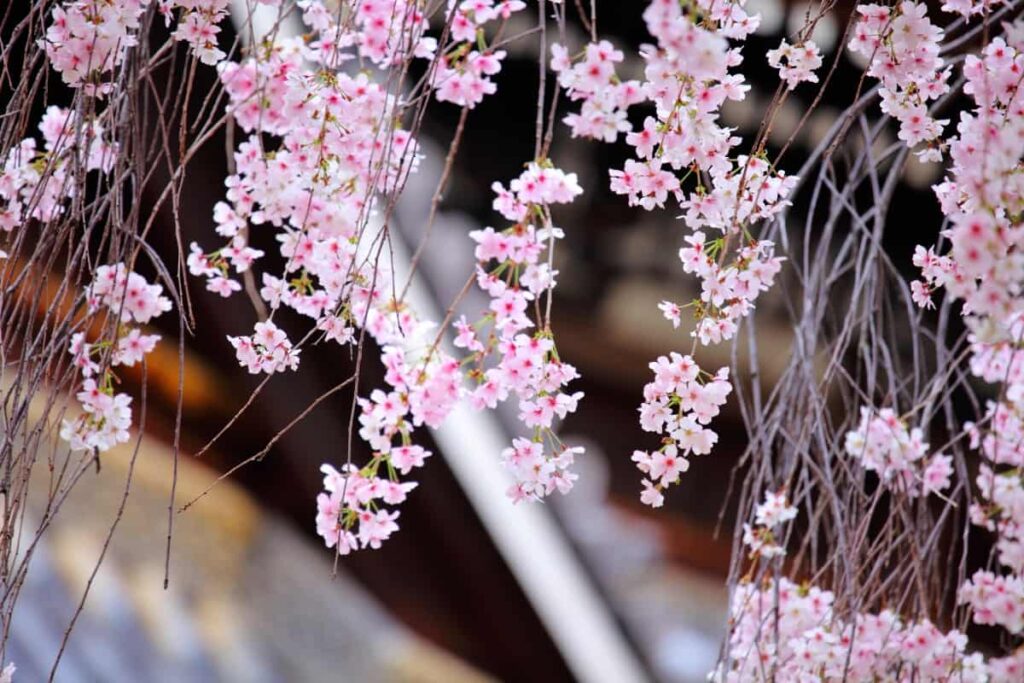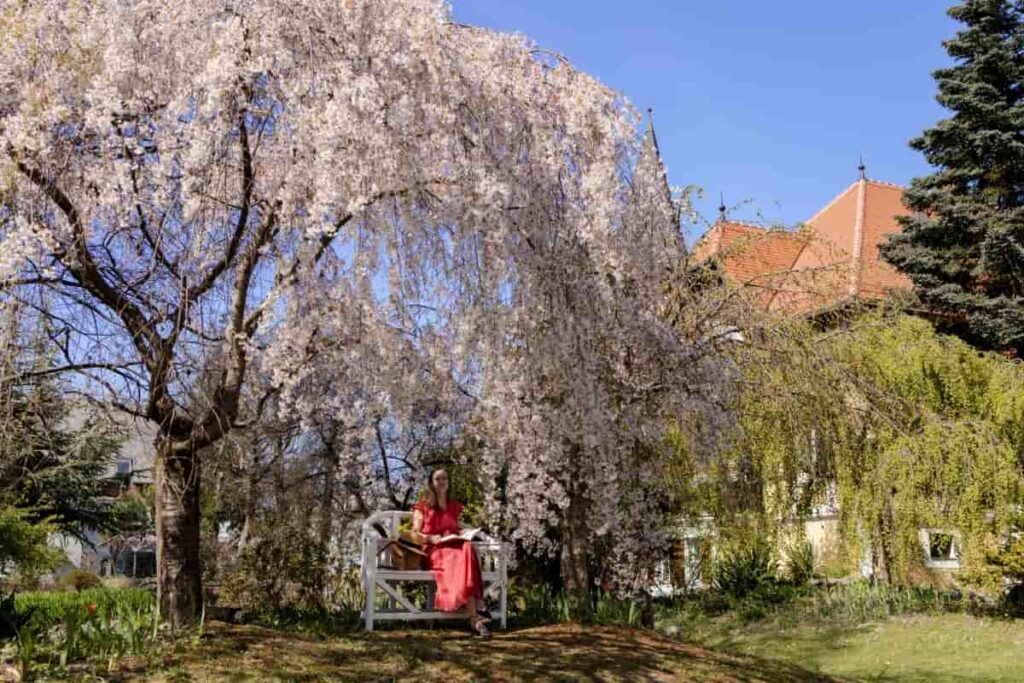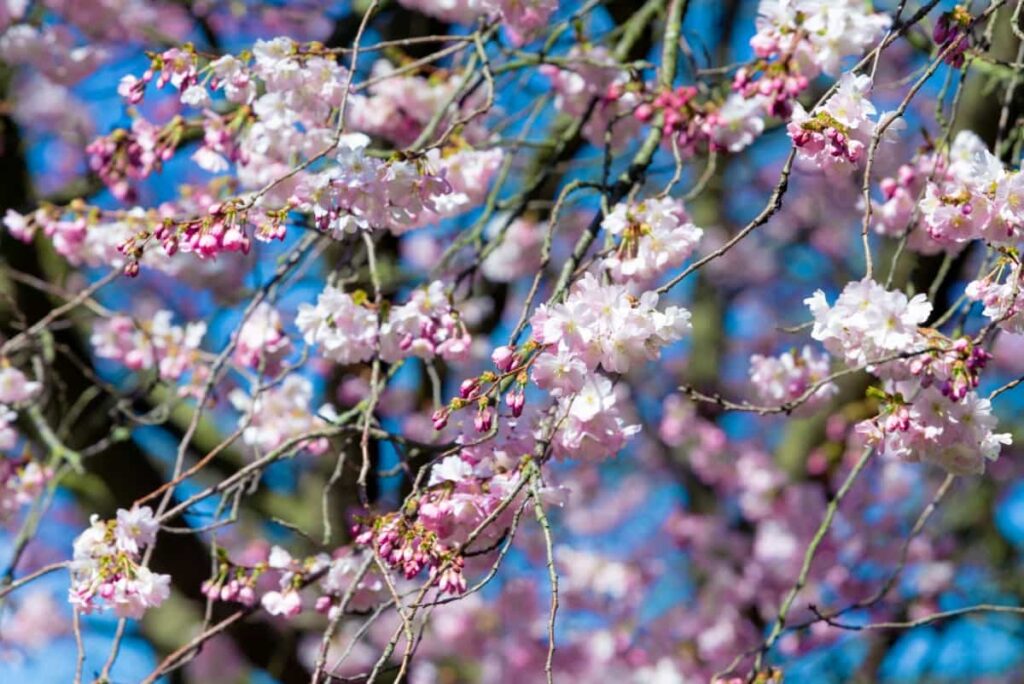Weeping Cherry Trees, scientifically known as Prunus subhirtella ‘Pendula,’ are a stunning addition to any landscape. These graceful trees belong to the Rosaceae family and are cherished for their elegant weeping branches. There is a wide variety of Weeping Cherry Trees available, each with its unique characteristics and flower colors ranging from white to pink. Whether you prefer the classic Yoshino or the vibrant Kwanzan variety, there is a Weeping Cherry Tree to suit every preference. These trees not only add visual interest but also attract pollinators, contributing to the ecosystem’s health.
Historical Significance and Ornamental Value
The Weeping Cherry Tree holds a rich historical significance dating back centuries. Originating in Japan, these trees were highly prized for their elegant beauty and symbolic value in Japanese culture. Traditionally planted around temples and imperial palaces, they symbolize the transient nature of life. In modern times, Weeping Cherry Trees are coveted for their ornamental appeal in landscaping and gardens worldwide.

Choosing the Right Location
Sunlight Requirements
When choosing the perfect spot to plant your Weeping Cherry tree, sunlight is key. These trees thrive in full sun exposure, so make sure to pick a location with ample sunshine throughout the day. By choosing a sunny place with well-draining soil, you set your Weeping Cherry tree up for success from the start.
Soil Conditions and Drainage
Weeping Cherry trees prefer well-draining soil that is rich in nutrients. Avoid areas with poor drainage, as waterlogging can harm the roots of the tree. Before planting, assess the soil quality and make amendments to optimal growing conditions for your Weeping Cherry tree.
Planting Your Weeping Cherry Tree
Best Time to Plant
The best planting time for a Weeping Cherry tree is in the early spring or fall, and the tree has a chance to establish its roots before extreme temperatures set in. This allows the cherry to establish its root system before the hot summer months.
Planting Process
Before you start digging, make sure you have chosen a location that receives plenty of sunlight and has well-draining soil. Once you’ve found the perfect spot, make a hole at least twice the width of the tree’s root ball but no deeper. Carefully remove the cherry tree from its container or burlap wrapping and gently loosen any circling roots. Place the root ball in the center of the hole and fill it with soil, tamping it down as you go. Water thoroughly after tree planting to help settle the soil around the roots.
Watering and Mulching
Watering Schedule
Establishing a consistent watering schedule is crucial, especially during the tree’s early stages of growth. Water deeply to encourage deep-root development. Regularly check soil moisture levels by sticking your finger into the ground near the root zone. Adjust your watering routine accordingly based on weather conditions and seasonal changes.
Benefits of Mulching
Mulching around the tree base offers numerous benefits. It helps retain soil moisture and insulates roots from extreme temperatures. Spread an organic mulch layer, such as wood chips or shredded bark, around the tree, making sure not to pile it against the trunk. Remember, a well-hydrated and properly mulched Weeping Cherry tree is more likely to thrive and reward you with beautiful blooms season after season.
Fertilization and Soil Management
Fertilizer Types and Application Timing
When it comes to fertilizing your Weeping Cherry tree, choosing the right fertilizer type is crucial. Look for a balanced fertilizer specifically formulated for flowering trees. Slow-release fertilizers are ideal as they provide nutrients over time, promoting healthy growth without the risk of burning the roots. As for application timing, it’s best to fertilize in early spring before new growth begins. This will give your tree a nutrient boost as it enters its active growing season.
Soil pH and Nutrient Management
Checking and managing soil pH is essential for optimal nutrient uptake by your Weeping Cherry tree. Aim for a slightly acidic soil pH between 6.0 and 6.5 for best results. Regularly monitoring nutrient levels in the soil will help you adjust your fertilization schedule accordingly to ensure your tree remains healthy and vibrant year after year.
In case you missed it: Cherry Tree Pollination: Understanding the Blossoming Process

Pruning and Shaping
Pruning Techniques
Pruning your Weeping Cherry tree is essential for its overall health and aesthetic appeal. Always use sharp tools to make precise cuts. Start by removing any diseased branches, followed by crossing branches that may rub against each other. Remember, proper pruning practices help maintain the structural integrity of your Weeping Cherry tree while preserving its graceful appearance in your landscape design.
Shaping for Aesthetics
Shaping for aesthetics involves creating a balanced canopy with an elegant drooping form. Focus on maintaining the tree’s natural shape while also ensuring proper light penetration throughout the canopy. Avoid over-pruning the tree, as this can stress the tree and lead to sparse foliage. Regularly inspect your Weeping Cherry tree for any signs of uneven growth or overcrowding within the canopy.
Pest and Disease Control
Common Pests and Diseases
Pest and disease control are important aspects of Weeping Cherry tree care. Common pests include aphids, spider mites, and caterpillars that can damage the leaves and flowers. To prevent infestations, regular inspection is key. Additionally, diseases like leaf spot and powdery mildew can affect the tree’s health.
Preventative Measures
The preventative measure is to promote good air circulation around the tree by pruning branches to allow sunlight in. This helps reduce humidity levels that contribute to fungal diseases. Another effective method is applying organic pesticides or neem oil to deter pests without harming beneficial insects. Remember, early detection is crucial in controlling any potential issues before they escalate into major problems for your Weeping Cherry tree.
Winter Care and Protection
Preparing for Winter
As the chilly winter months approach, it’s essential to prepare your Weeping Cherry tree for the harsh weather ahead. Start by giving it a deep watering before the ground freezes to help it stay hydrated during the dormant season. If you notice any winter damage signs, come springtime, such as cracked bark or dead branches, don’t panic. With proper care, your Weeping Cherry tree can recover beautifully and thrive once again in the warmer months ahead.
Winter Damage Recovery
To protect your Weeping Cherry tree from winter damage, consider wrapping its trunk with burlap or using a protective tree wrap. This will shield it from extreme temperature fluctuations and prevent sunscald on sunny winter days. Mulching around the base of your Weeping Cherry tree can also provide insulation against freezing temperatures.
In case you missed it: Best Fertilizer for Cherry Trees: Organic, Natural, Homemade, NPK Ratio, and Schedule

Propagation and Reproduction
Methods of Propagation
Propagation is an essential aspect of caring for your Weeping Cherry tree. There are various methods to propagate Weeping Cherry trees successfully. One common method is through grafting, where a scion from a desirable Weeping Cherry tree is attached to the rootstock of another tree. Propagation through methods like grafting can be a rewarding way to expand your collection of Weeping Cherry trees and create unique specimens in your garden or landscape.
Grafting for Success
Grafting allows you to create new trees with specific characteristics that you desire, such as flower color or growth habit. It’s a delicate process that requires precision and patience, but when done correctly, it can result in healthy and thriving new trees. When grafting your Weeping Cherry tree, make sure to choose scions from mature and healthy trees. The success of the graft largely depends on the health and quality of the scion you select.
Troubleshooting Common Problems
Leaf Discoloration and Drop
Weeping Cherry Tree leaf problems can be a common concern for many gardeners. Leaf discoloration and drop may indicate underlying issues such as nutrient deficiencies, pests, or diseases. To troubleshoot this problem, start by checking the soil pH to ensure it’s within the optimal range for cherry trees. Adjusting the soil acidity can help improve nutrient uptake. If you notice discoloration, spots, or abnormal dropping of leaves, investigate the potential causes and address them promptly.
Lack of Blooms
If you notice a lack of blooms on your Weeping Cherry tree, inadequate sunlight exposure might be the culprit. These sun-loving trees require 6 hours of sunlight daily to thrive and produce abundant blossoms. Prune surrounding branches if they are shading the tree excessively. Consider adding a balanced fertilizer high in phosphorus to promote blooming.
In case you missed it: Golden Berry Farming in India: Best Cultivation Practices for Cape Gooseberry

Conclusion
Weeping Cherry tree care is essential for maintaining the beauty and health of this stunning ornamental tree. To ensure your Weeping Cherry thrives, it’s crucial to understand its specific needs. Maintaining the elegance of your Weeping Cherry tree is essential to ensure its health.
- Irrigation and Water Management in Pineapple Farming
- Blossom to Harvest: Mastering Flowering and Pollination in Papaya Farming
- Pig Fattening Essentials: From Selection to Sale for Beginners
- Raising Wagyu Cattle: A Complete Guide for Premium Beef Production
- Soil Types and Their Water Holding Capacity
- Optimizing Irrigation Schedules for Coconut Groves for Enhanced Yield
- Espresso Your Garden: Coffee Grounds for Healthier Acid-Loving Plants
- The Best Soil Mix for Snake Plants: How to Mix Your Own Snake Plant Soil
- Green Thumb Success: Expert Tips for Cultivating Greenhouse Beans All Year Round
